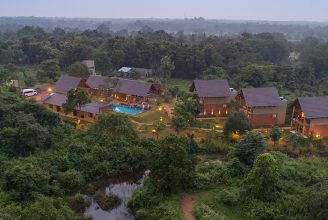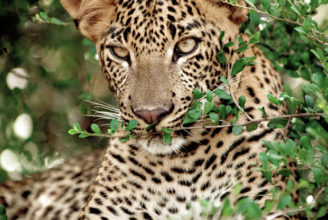Anuradhapura
A Sacred City
The Sacred City of Anuradhapura stands equal to the Pyramids at Giza on an architectural level. This magical UNESCO World Heritage Site with enormous Dagobas, palaces, monasteries and monuments is evidence of one of the greatest civilisations in the world. The sacred city of Anuradhapura was the first Royal Kingdom and capital of Sri Lanka that lasted for 1,500 years until it was abandoned after the invasion by South Indian Cholas in 993. Today Anuradhapura is one of the world’s major archaeological sites in the world. It covers an area of about 40 km² and was established around a cutting from the ‘tree of enlightenment’, the Buddha’s fig tree, in the 3rd century B.C. by Sanghamitta, the founder of an order of Buddhist nuns. The ruined city hidden away in dense jungle for many years was brought to life by The British in the nineteenth century.
Anuradhapura, a UNESCO World Heritage Site, is the magnificent former capital of Sri Lanka and the sacred cradle of the island’s Buddhist culture. Flourishing for over 1,300 years (4th century BC to 11th century AD), this sprawling ancient city is a landscape of colossal brick stupas, sophisticated hydraulic engineering, and spiritual monuments that tell the story of a millennia-old kingdom.
Overview: A City Built on Faith and Water
The ancient city of Anuradhapura was the first established kingdom on the island and remains one of the world’s oldest continuously inhabited cities. Its rise to prominence is intrinsically linked to the introduction of Buddhism in the 3rd Century BC and the subsequent development of an unparalleled irrigation system, utilizing vast reservoirs (“tanks”) to sustain the civilization. Today, the ruins cover an extensive area, offering an awe-inspiring glimpse into the grandeur of ancient Sinhalese architecture and devotion.
Essential Sites and Unmissable Highlights
Anuradhapura is home to the Atamasthana (Eight Sacred Places), the principal sites of reverence for Buddhists.
1. Jaya Sri Maha Bodhi (The Sacred Bodhi Tree)
- The World’s Oldest Documented Tree: This is the heart of Anuradhapura’s spirituality. It is a sacred fig tree grown from a cutting of the original Bodhi Tree in Bodh Gaya, India, under which the Buddha attained enlightenment.
- Significance: Brought to Sri Lanka in the 3rd Century BC by Sanghamitta (the daughter of Emperor Ashoka), it is the oldest historically authenticated tree planted by a human and remains a highly active, revered pilgrimage site.
2. The Great Stupas (Dagobas)
Anuradhapura is defined by its massive, hemispherical brick structures called stupas or dagobas—monumental relics second in size only to the Great Pyramids of Giza.
- Ruwanwelisaya: The “Great Stupa” is arguably the most famous and most beautiful. Built in the 2nd Century BC by King Dutugemunu, its gleaming white dome is surrounded by a wall adorned with hundreds of carved elephants. It is one of the holiest sites in Sri Lanka.
- Jetavanaramaya: Once the tallest stupa in the ancient world, standing at approximately 122 meters ( feet). Built in the 3rd Century AD, it is an astonishing engineering feat, using an estimated 93 million bricks, and highlights the mastery of ancient construction.
- Abhayagiri Dagaba: Built in the 1st Century BC, this massive stupa was the center of a large monastic complex that housed thousands of monks and was an international center for Buddhist learning.
- Thuparamaya: The very first stupa built in Sri Lanka, constructed immediately after the introduction of Buddhism, and believed to enshrine the collarbone relic of the Buddha.
3. Architectural Wonders
Beyond the colossal stupas, the site showcases intricate examples of ancient art and civil engineering:
- Isurumuniya Temple: A charming rock temple famous for its exquisite 6th-century stone carvings, including the renowned “Isurumuniya Lovers” and carvings of elephants emerging from a pond.
- Kuttam Pokuna (Twin Ponds): A magnificent example of ancient Sinhalese hydraulic engineering. These exquisitely designed bathing tanks are architecturally perfect, featuring complex water inlets, filtering systems, and steps leading down to the water.
- Samadhi Buddha Statue: A beautifully carved statue of the Buddha in the meditative posture ( ), widely considered one of the finest pieces of classical Sinhalese sculpture.
- Moonstones (Sandakada Pahana): Look for the highly decorated, semi-circular stone slabs at the foot of staircases. The most famous example in Anuradhapura depicts concentric bands of animals (elephant, lion, horse, bull) representing the journey of life.
Visitor Tips
- Sacred Site: Anuradhapura is an active place of worship. Visitors must be dressed conservatively (shoulders and knees covered) and remove shoes and hats at all religious sites.
- Getting Around: The site is massive, spanning over 40 square kilometers. The best ways to explore are by hiring a bicycle, a tuk-tuk, or a private car and driver.
- Mihintale: Located a short distance away, this mountain peak is where Buddhism was first introduced to the island and is highly recommended for panoramic views, especially at sunrise or sunset.
Local Hotels

Unsure Where To Start?
Let’s talk about your Earth Trip


Our travel specialists are seasoned explorers with deep local insights. Whether it’s uncovering hidden gems or planning immersive cultural experiences, we design trips that go beyond the ordinary. Get in touch today!
Request A Video Meeting











 Anuradhapura
Anuradhapura